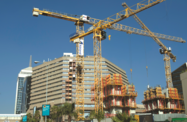The slow rollout of state infrastructure projects and subdued activity in the private sector is once again putting pressure on South Africa’s construction industry, prompting some firms to expand activity abroad by tapping into regional markets.
Upgrading South Africa’s physical infrastructure, including roads, pipelines, railways and electrical networks, has been a priority for the government, with spending commitments totalling $96bn over the next three years. It is hoped that this outlay will attract additional funds for the initiative from the private sector, potentially up to another $52bn, which President Jacob Zuma recently described as the catalyst to sustainable economic development.
The spending programme, unveiled in February, sets out more than 150 separate projects and in the long term, the government foresees $456bn worth of infrastructure investments to be made over the next 15 years, paid for through a mix of public and private funding.
However, there has been concern over the pace of progress, with actual developments slow in coming. Project delivery has been a challenge in previous years, with only 68% of the planned projects in fiscal year 2010/11 actually carried out. This has had a direct impact on the operations of many construction firms.
Angus Band, the chairperson of Aveng, a construction and engineering group, said the market remained tight, with tenders taking much longer to be awarded and contract terms increasingly onerous.
“In South Africa, the envisaged $96bn public sector infrastructure spend has not yet translated into increased tender activity in the local market,” he said in a statement issued at the group’s annual general meeting on November 8.
Stefanutti Stocks, a South Africa-based construction group, has also been impacted by the delays. In a statement issued on November 13, Stefanutti said its earnings had fallen and that the sector had been weakened by the slow rollout of developments.
“This has negatively affected activity levels in the South African construction sector for a number of years now and has led to aggressive competition among contractors‚ as can be seen by low-margin projects throughout the industry‚” the firm said.
Given the sheer of volume of work that is currently in the pipeline, alongside an expected recovery in domestic demand, the medium- and long-term outlook for the sector is encouraging. However, it will likely remain under pressure in the near term, with private sector spending low and new projects thin on the ground.
That pressure has been reflected on the Johannesburg Stock Exchange (JSE). The construction index was up just 1% this year as of mid-November, compared to the rise on the all-share index of some 15%.
According to Paul Stuiver, the CEO of PPC, a local cement producer, the effective rollout of the government’s infrastructure programme could potentially ensure a sustained rebound for the cement segment. Stuiver added any further domestic bottlenecks could be offset by expansion abroad.
“We might have a slowdown in South Africa over the next few years, but the rest of Africa is growing very strongly,” Stuiver told local media website Engineering News in November.
Indeed, in early November, civil engineering group Protech Khuthele said it would be targeting selected projects in Zambia, Zimbabwe and Mozambique to sustain growth, and Afrimat, a construction materials supplier, announced at the beginning of the same month it was also considering expansion into Mozambique and Zambia.
Andries Van Heerden, the CEO of Afrimat, believes expansion outside the country could account for up to half of the firm’s revenue within five years. “We are not cutting back on our investment in South Africa, but it would be foolish not to have more arrows in your bow,” he said.
A number of major construction firms have already initiated projects outside South Africa, with Stefanutti reporting around 25% of its earnings coming from abroad. The WBHO Construction Group reported in September that 67% of the projects on its order books were for foreign clients.
The increasing number of domestic construction companies looking to broaden their horizons will help boost the sector’s standing on the JSE and give many of these firms some breathing space until the government is able to step up its own spending programme. While it may be difficult in the near term for smaller firms, or those without access to foreign markets, larger companies and those with the ability to cash in on the strong economic development in other parts of the continent should prosper.

